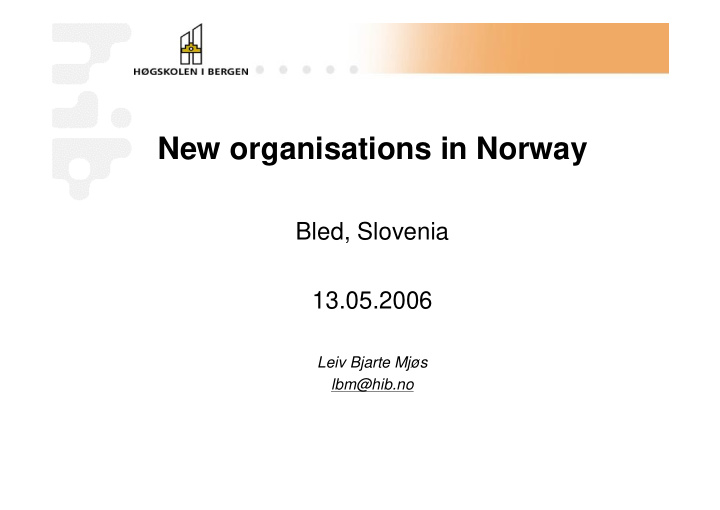



New organisations in Norway Bled, Slovenia 13.05.2006 Leiv Bjarte Mjøs lbm@hib.no
Norway in statistics • Total area 324.000 sqkm • 4,5 million inhabitants • 2,4 million properties • 95 % of properties in private ownership • 80 % of families own their house • 99 % of farms owned by private, single farmers - 20 hectares on average • Only high mountains in general state ownership • Almost all construction financed by mortgaging, total value of registered collateral 2000 billion NOK = 3 x annual state budget
Development in Norway • Implementing two reforms: • Reform of the land register • New law on the cadastre
Reform of the land register • The land register is moved from 87 local courts to one single registration office at Statens kartverk (Norwegian Mapping Authority) from 2004-2007 • Why: • Making courts concentrating on rule of law • Reducing number of courts • Recognising that the administration can ensure legal security in land registration as well as courts • Recognising the benefit of better co-ordination between cadastre and land registration, particularly in development issues • Getting uniform services throughout the country • Lowering costs. Staff reduction by 25 % from 200 to 150 • Facilitating electronic documents from 2007?
Implementation of the land register reform • Land registration services and archives transferred to Statens kartverk court by court over a period of 4 years • Parallel to reducing the number of courts • Parallel to implementing a new IT-system at central level • Maintaining uninterrupted services • The Cadastre and Land Register will be kept as separate databases, with an integrated one-stop access for users
New law on the cadastre • New law passed the Parliament in June 2005 • planned to be in force 1.1.2007 • Present law on the cadastre was put into force in 1980, main new elements in 1980 was: • New cadastral register – GAB • Database operated by the ministry/Statens kartverk • The municipalities responsible for registration of data • Not integrating cadastral map • Compulsory land survey of new boundaries • Municipal monopoly on legal boundary surveys • Unique property numbers nationwide
Why new law on cadastre? • Poor data quality in the Cadastre (GAB) • Many municipalities are too small and weak, and the services are poor • No on-line access to nationwide cadastral maps • But presented on web-sites by some municipalities • No registration of public restrictions on land • No provision for making properties in strata • Long waiting times for surveys in some municipalities • Large variations in prices for surveys (1000-3000 USD) • Limited service from the municipalities to clients; focus on surveying boundaries only
New law on the cadastre – main elements • To be achieved: • Better services to users • Better quality in registers • meeting new demands of the land market • By: • Adding a digital cadastral map to the national register • Registering public restrictions in the cadastre • Adding two new types of property objects: • volumes under or above the surface, 3 D properties • land in joint ownership • Introducing private licensed surveying companies
Private land surveyors • Today: • Municipal monopoly on legal land surveys • no specific requirements for education • From 1.1.2007 • New law providing legal basis for private surveying companies to do cadastral surveys • Leading surveyor in surveying company – master or bachelor • 140 ECTS in surveying, law, land management • Regulated in by-laws - now on public hearing • The municipalities shall update the cadastre • Can leave over the updating to Statens kartverk • The municipalities can decide to continue the arrangement with legal surveys as a municipal monopoly task (!) • Private surveying companies will then not get access, unless engaged by the municipality
Land disputes • A special court - The land consolidation court handles disputes over boundaries and other land rights • The judge must be a special surveyor with a 5 year degree (master) • The land consolidation court also makes the related cadastral surveys
Education of land surveyors • 2 institutions have announced that they will offer a study programme that will fulfil the demanded ECTS: • University of Life Sciences (Ås) • Bergen University College • Bachelor programme in Land management and property design starting autumn 2006
Thank you!
Recommend
More recommend